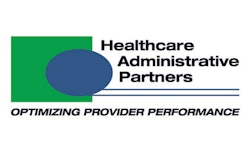
The Consolidated Appropriations Act, 2021 (CAA) is a sweeping piece of legislation that provides relief to individuals and businesses impacted by the COVID-19 public health emergency. Some of the relief provisions apply to all businesses, including medical practices, but it also contains several measures that specifically apply to radiology.
Medicare Payment Revisions
 Rebecca Farrington from Healthcare Administrative Partners.
Rebecca Farrington from Healthcare Administrative Partners.The Medicare Physician Fee Schedule (MPFS) Final Rule that was issued early in December 2020, contained a 10.2% reduction in the conversion factor and a projected 10% cut in diagnostic radiology reimbursement. The CAA revises the conversion factor to $34.89, which is a 3.3% reduction from the 2020 rate.
However, a comparison of the new relative value unit values with those in the December MPFS Final Rule shows that many procedures have received slightly downward adjustments. The net effect estimated by the American College of Radiology is a decrease of 4% in payment for radiologists, as contrasted with the 10% cut that was estimated in the MPFS Final Rule.
The dramatic reduction in the original MPFS was due to the upward revaluation of evaluation and management services, including the introduction of a new add-on code (G2211) for complex office visits. The CAA delays the use of G2211 until 2024, thereby mitigating the impact of the other valuation changes.
The Medicare sequestration withhold of 2% on payments to physicians was suspended by the CARES Act as of May 1, 2020. It was scheduled to resume on January 1, 2021, but the suspension has now been extended through March 31, 2021. This will provide practices with some additional relief as they continue to recover from the public health emergency.
Surprise billing
Beginning in 2022, practices will have to comply with the "No Surprises Act" contained in the CAA. This will limit payment for services provided out-of-network to the amount that would have been paid to an in-network provider. We will provide a thorough analysis of this new requirement in plenty of time for your practice to prepare for it.
Paycheck Protection Program
The CAA introduced a second round of Paycheck Protection Program (PPP) loans and changed some of the provisions related to both the first and second loans. The loan program is extended through March 31, 2021, although the eligibility of businesses to receive a second loan will be more narrowly defined than for the first loan, including the necessity to demonstrate a 25% reduction in revenue between comparable quarters in 2019 and 2020.
The loan forgiveness terms remain the same as for the first round of funding, but the list of permissible expenses for both first- and second-round loans has been expanded. At least 60% of the expenditures must still be for payroll-related costs. The bill also clarified that expenses paid using nontaxable PPP loan funds will be tax deductible to the same extent as they would be if paid from general revenues, reversing an earlier ruling by the Internal Revenue Service.
Employment provisions
The CAA also extended some other provisions of the CARES Act related to employee retention and family leave. The special paid sick leave and extended family leave provided by the Families First Coronavirus Response Act (FFCRA) has been extended through March 31, 2021.
However, while it is now optional for employers to provide this benefit, the employer will continue to receive the same level of tax credits to cover the cost of providing the leave to their employees. The total length of leave available to employees was not extended, only the time during which the leave may be used.
The Employee Retention Credit (ERC) was made available by the CARES Act to employers of up to 100 employees that had experienced a reduction of at least 50% in gross receipts as compared with the same quarter in 2019. It was not available to practices that received a PPP loan.
The ERC has now been extended for wages paid from January 1 to July 1, 2021, and many of its provisions have changed. It is now available to practices that received PPP loans, retroactively for wages paid after March 12, 2020, but it may not be claimed for wages paid using the funds subject to PPP loan forgiveness. Practices should consult with their financial advisor to determine the applicability of the ERC for their practice.
Conclusion
The rollback of the Medicare fee schedule cuts is welcome news to radiology practices that were anticipating a much more significant decline in revenue this year, but inevitably the reductions will be fully phased in. The regulations contained in each relief measure described here are complex, and nothing in this article should be construed as legal advice; practices should consult with their accountants, attorneys, or other advisors as necessary.
We will continue to keep you aware of developments as they occur.
Rebecca Farrington serves as the chief revenue officer for Healthcare Administrative Partners. She has more than 20 years of experience in healthcare sales and management roles, focusing on hospital-based and physician revenue cycle management.
The comments and observations expressed are those of the author and do not necessarily reflect the opinions of AuntMinnie.com.



















